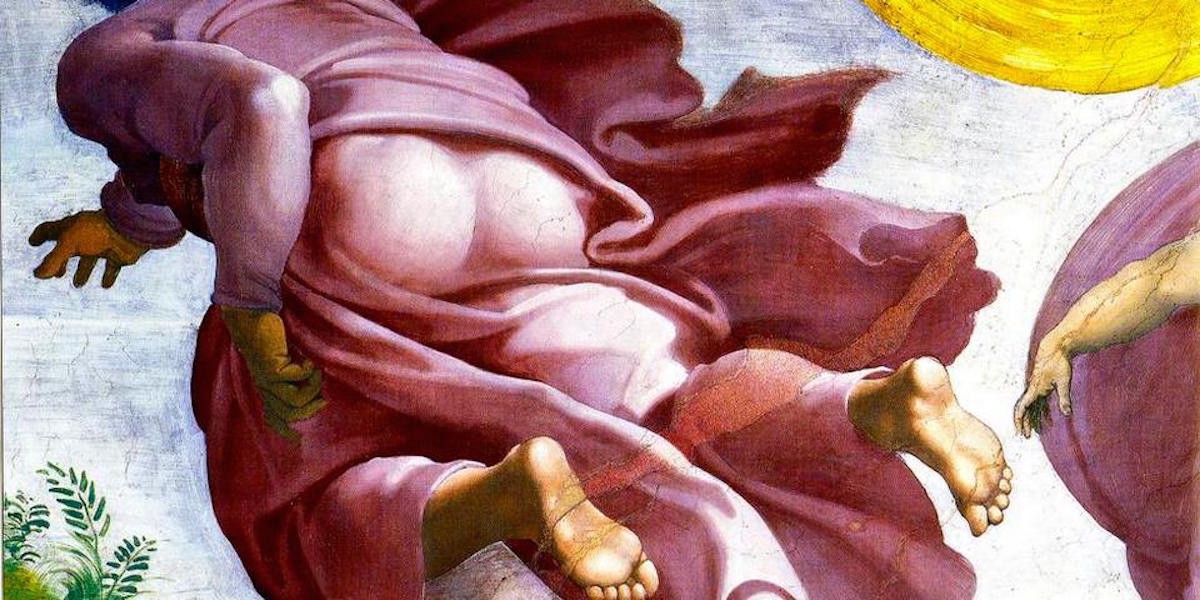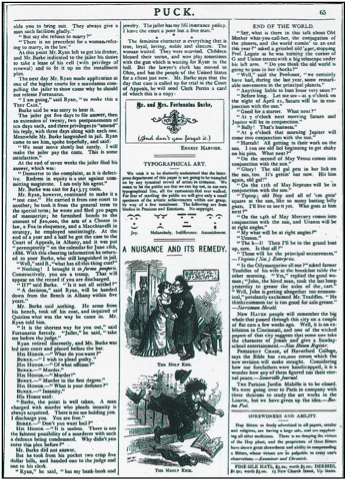Books & Culture
A Deep Dive Into Uranus Jokes
Exploring the 19th-century roots of a low humor staple

Uranus, it has been pointed out, has long been the butt of jokes. As an initiation for those unfamiliar with the genre, I offer the ne plus ultra of Uranus humor:
Q: Why are the U.S.S. Enterprise and toilet paper alike?
A: They both hunt for Klingons in the rings around Uranus.
Well, that’s out of the way. Sorry if the low humor discomfits, but when writing about Uranus jokes, it is the nature of the business.
Most of us heard, and then gleefully repeated, our first Uranus jokes during childhood. The scatological juvenile obviousness inherent in the myriad variations of these essentially identical gags did not and will never diminish our appreciation of them. (There is no definable difference between good Uranus jokes and bad Uranus jokes — there are only Uranus jokes.) My own introduction to Uranus jokes must have come close to half a century ago, and certainly the playground comedian who related the jape was working solidly within a received older tradition. But how old might that tradition be?
There is no definable difference between good Uranus jokes and bad Uranus jokes — there are only Uranus jokes.
Certainly, no planet Uranus joke can predate March 13, 1781, as that was when astronomer Sir William Herschel first discovered the celestial body from the garden of his house in Bath, England. Okay then, you say — the tradition started March 14, 1781. But the story of the planet’s nomenclature is more involved, as Herschel didn’t just peer through his telescope and say “I can see Uranus.” The astronomer’s name for the object he discovered (and at first misidentified as a comet) was Georgium Sidus, after King George III. According to Mark Littmann in his 2004 tome Planets Beyond: Discovering the Outer Solar System, that appellation proved “instantly unpopular” wherever the monarch did not reign. German astronomer Johann Elert Bode, one of the first observers to properly identify the body as the seventh planet from the sun, named it Uranus after the father of Saturn and grandfather of Jupiter in ancient Roman cosmology. However, writes Littmann, “The new planet remained officially ‘The Georgian’ in Britain until after the discovery of Neptune and through the 1847 publication of the Nautical Almanac for 1851.”

Okay then, you say — the tradition started no later than 1851, at least among the English speaking peoples. In the absence of documentation, however, that would be mere speculation. Something as elusive as the earliest appearance in print of a Uranus joke would seem very difficult to track down, unless the planets all lined up just so.
The Conjugation of the Planets
I was set on the circuitous path to the first Uranus joke by sheer chance, via a history book for general readers titled 100 Diagrams That Changed the World. In it, author Scott Christianson identifies the first print appearance of an emoticon, a type of diagram defined by Wikipedia as “etymologically a portmanteau of emotion and icon…a metacommunicative pictorial representation of a facial expression that, in the absence of body language and prosody, serves to draw a receiver’s attention to the tenor or temper of a sender’s nominal non-verbal communication, changing and improving its interpretation.” (There are other, simpler definitions of “emoticon” I could have used, but none that are as spectacularly annoying.)
Emoticons first appeared in an American satirical magazine called Puck on March 30, 1881. This is what the original ones looked like.

Christianson reproduces the entire page of the periodical, showing the busy layout in which the first emoticons were buried.

Curious as to what constituted satire in 1881, I read the copy surrounding the emoticons, and came across the heading “END OF THE WORLD,” top right. The text below recounts an unfortunate interaction between a professor carrying a telescope and a “grizzled old ‘49er” concerning the “conjugation of the planets.” The professor describes his findings about the solar system to the loquacious ‘49er, explaining to the old man that Mercury, the Sun, and Uranus are set to align at right angles. You can read the end of the exchange for yourself in the clip below — the key passage appears in the last eight lines, though by all means start at the beginning for the full comic effect.

So there you have it, a Uranus joke from 1881 — AND IT’S STILL FUNNY!
Is it Uranus Joke Zero, though? The attribution indicates that the joke was reprinted from the Virginia Enterprise of Nevada, attesting to a longer-lived frontier tradition. (Intriguingly, Samuel Clemens first used the pen name “Mark Twain” when writing for the very same Enterprise in 1863, though no mention of the planet occurs in his writing for that publication.)
What we can surmise is that in 1881, three decades after the consensus agreement about the name of the seventh planet from the sun in a world without mass electronic communications (but not without playground comedians), a Uranus joke was still novel enough to merit inclusion in a noteworthy satirical publication in New York City. Unless the punchline is actually “Those will be the principal occurrences,” which I wager it is not.
So here was a curious historical convergence on that one page of Puck magazine — the first emoticons and a 136-year-old Uranus joke. Is it possible that the joke was also the first of its kind? I wanted to find out. Before we leave Puck, however, I would be remiss if I didn’t call attention to the cartoon on the same page about a lecherous clergyman.

That kind of stuff is also evergreen. ;‑)
Uranus is Newsworthy
The first time “Uranus” appeared in a U.S. newspaper (at least, one that has been digitized by the Library of Congress) comes in 1838, when the New York Morning Herald listed a ship by that name in its September 24 edition. A second citation appears in the Rutland, Vermont Herald in February 1840, in an article picked up from the Journal of Commerce titled “An Idea of the Universe” that explores Herschel’s astronomical work. At that time, the seventh planet Uranus represented the farthest known reaches of our solar system.
The biggest astronomic story of the 1840s was the discovery of Neptune, the eighth planet from the Sun, which was posited mathematically in 1843–45 by the brilliant British professor John Couch Adams after he noticed irregularities in the orbit of Uranus. Adams not only concluded that another planet was responsible, but worked out on paper its location in the solar system. Due to academic arrogance and snobbery, the Royal Observatory’s leadership ignored Adams’s work (a saga detailed in the “Trouble with Uranus” chapter of Planets Beyond). Within a few years, multiple Continental astronomers independently arrived at the same conclusion and soon located Neptune via telescope. The German faction wanted the new planet to be named Janus, the British Oceanus, and the French (who first made the official identification and thus had naming rights) wanted Neptune. Eventually, the name Neptune was adopted, thus thwarting the development of a parallel folkloric tradition of planetary low humor.
American newspapers starting covering the discovery in 1846, when articles about the odd behavior of Uranus started to appear. In a letter to the editors of the Weekly National Intelligencer, astronomer Sears C. Walker explained the most recent scientific findings, concluding his missive as follows:
When the particulars of Prof. Peirce’s computations are made known, astronomers will see in the still unexplained perturbations of Uranus a source of hope, and, I may add, a stimulus to exertion for a further enlargement of the boundaries of the system.
While elements of potential Uranus humor may be said to be present — seeing a “stimulus to exertion” in “perturbations of Uranus”— Mr. Walker’s letter is clearly intended to enlighten rather than amuse. The phraseology might have been good for a chuckle by the cognoscenti, but an intentional subtext is unlikely.
A False Start
The first discernible stage of the modern Uranus joke’s evolution occurred in 1852, a year after “The Georgian” ceased to be the standard English-language name for the planet. This front page editorial in the Baton Rouge Daily Comet titled “Mechanics and Manufactures” is a hoary bit of civic boosterism promoting Louisiana’s capital as a city of the future, and is addressed
not to the bloated nabob who believes nothing good, that has not a foreign savor — and who sends his shirts abroad to be washed because of the miserable quality of home starch: we are not talking to these people, we address ourselves to the frugal and the industrious, and prosperous and happy population of the transcendently great and enlightened Pelican State…
The editorial cites the many advantages Baton Rouge offers to manufacturers, and then takes the opportunity to blow the newspaper’s own horn, albeit in a way that this modern reader finds perplexing.
It would be wrong to close this article without speaking of ourselves. There is nine sterling literary and political papers in this place, viz : The Vis-a-Vis and the Gazette is two, and the Vis-a-Vis and the Advocate is four, and the Vis-a-Vis and the Comet is six, and the Vis-a-Vis and the Capitolian Vis-a-Vis is eight — where in the ninth? Well we will set the Vis-a-Vis down for the odd number. We would like for nine more papers to be found anywhere this side of Uranus, to compare with these in wit — pith — point — or parts of beauty; if any of our editorial compeers will drum them up we will never brag more.
Here the citation of Uranus may be construed as denoting the far outer edge of the solar system, but hey, it was 1852 — it could have read Neptune. Although there is no way to ascertain the editors’ intent, the tone of the editorial is clearly jocose and I suspect that the double entendre would have registered with the happy population of the transcendently great and enlightened Pelican State, which would later give us tunes like “I Thought I Heard Buddy Bolden Say.”
The Comet editorial approaches, but does not conclusively establish itself as, Uranus Joke Zero — call it instead an ur-Uranus joke.
The Comet editorial approaches, but does not conclusively establish itself as, Uranus Joke Zero — call it instead an ur-Uranus joke. For one, it seems to be an evolutionary dead end — I could find no other Uranus jokes either in the Comet or contemporaneous publications. In fact, Uranus humor would actually take an evolutionary step backward in the decades to come.
Uranus Fails
By the 1870s, three potential Uranus jokes circulated among American newspapers. Remarkably, none seize upon the double entendre.
The most popular, “About Astronomy,” was authored by M. Quad (pen name of Charles Bertrand Lewis, one of the foremost humorists of the day) for the New York Graphic. More of a set piece than a joke, the anecdote (similar to “End of the World”) involves a bumpkin’s encountering a professor with a telescope. The professor, who has set up the telescope in a busy public square, invites the bumpkin — “a young man who prefers to feast his soul with scientific knowledge rather than become a sordid, grasping, avaricious capitalist” — to observe the planet Venus. Alas, the bumpkin instead points the telescope at a fifth story window and exclaims: “I see a feller hugging a girl!… [D]urned if there isn’t a dozen of them!”
The story continues in this vein down the roster of planets, finally reaching Uranus.
“You are now looking at Uranus,” replied the Professor. “Uranus is 97,502,304 miles distant from the earth, and yet I warrant that it doesn’t appear over 80 rods away to you. Will you be kind enough, my friend, to tell this crowd what you see?”
“Give it to him! Whack him back! Go in, old woman!” shouted the [bumpkin], slapping one leg and then the other.
“Speak up, my friend. What do you see?”
“That’s it! Got him by the hair now. I’ll bet fifty to one that she’ll lick!”
“Won’t you be kind enough, my friend, to tell this crowd what you see!”
“Whoop! That’s it now she’s get him purtiest family fight I ever saw!” cried the young man as he moved back and clapped his hands.
Heh-heh. Heh-heh. Ehhhhhh. So it’s not exactly a knee slapper (cut to the big finish — the bumpkin is actually a plant whose titillating observations are designed to drum up a crowd, to which the professor tries to hawk tooth powder), but it tickled the funny bones of enough editors across the nation to appear in at least six other newspapers, several times on the front page.
As I researched 19th-century newspapers, I was surprised by how many times I encountered the same articles in rural and frontier journals far from urban centers, often within weeks of their original publication dates. I was also impressed by the depth, breadth, and sophistication of the news and feature stories — Americans of that era who read their local papers would have been very well informed. “It must not be thought that country papers were generally contemptible or negligible in this period; the contrary was true,” wrote Frank Luther Mott in his 1961 history American Journalism. “There were over 12,000 of them by 1890; they had more than tripled in twenty years,” Mott observes. Content was shared in several ways — for one, the exchange of papers between publishers had been carried gratis by the US Post Office since 1792 to facilitate the dissemination of important news, ideas, and political messaging. More significantly, writes Mott, “by 1880, more than 3,000 weeklies…were supplied with readyprints by twenty-one companies,” content distributed in the form of metal sheets that became known as “boilerplate,” the origin of the term still used today.
By the 1870s, three potential Uranus jokes circulated among American newspapers. Remarkably, none seize upon the double entendre.
The plates moved nationwide rapidly by train, and so one will repeatedly encounter humorous miscellany like this second Uranus joke fail, a lament called “Tall Men” putatively written by a short fellow. “I am always sorry for a tall man,” the writer begins, because “a very tall man is always pursued, haunted by one unvarying joke. Every short or ordinary sized man that approaches him throws back his head, affects to gaze up into the heavens with a very painful effort, and asks, ‘Isn’t it pretty cold up where you are?’” The writer concludes,
I wish I was the Colossus of Rhodes and a little man four feet eleven and a half would come up to me some day when I felt right good, and stare up at me with a grin longer than his body and ask me “If it wasn’t pretty cold up there” and I would hold him up by the neck, and I would swing my brazen leg until I got the motion and impetus of a walking beam, and then I would kick the little fellow so high that he could read the names of the streets on the street lamps in Uranus, and I would sarcastically shout after him, “No, it’s red hot!”
The piece is characteristic of American humor writing of the day, overwritten and none too funny. It is frequently hard to discern just what exactly what the reader is supposed to find amusing in many of the jokes, with one overriding exception — crude ethnic humor. Even in mainstream publications, stereotyping was pervasive, with reappearing stock characters such as the lazy Negro, the conniving city slicker, the clueless hillbilly, the stuffed shirt blueblood, and, as seen in this third (seemingly sui generis) Uranus joke fail from the Pacific Northwest 1878, the vainglorious sozzled Irishman.

Perhaps publications in the 1870s were too restrained by contemporary mores and genteel sensibilities to seize upon the comic potential inherent in the obvious double entendre. That reticence, however, would soon change.
Back to the End of the World
The trail to Uranus Joke Zero eventually led back to “End of the World.” The joke originally appeared on page 3 of the Virginia Daily Territorial Enterprise on February 16, 1881, but with two crucial differences to the version published in Puck magazine. First, it featured a subhead: “A Man Who is Anxious to See the Grand Wind-Up in the Set-to Between the Planets.” The second difference is that the joke doesn’t wrap up with the professor’s line, “Those will be the principal occurrences”; instead, the grizzled old ‘49er has some additional dialogue.

I know — ¯\_(ツ)_/¯. As the joke reads in its unredacted form, it seems as if the object of the humor is meant to be the apocalyptic ravings of a coot ‘49er, and not Uranus at all. The subhead would also signal as much, and maybe this was done to camouflage the subversive ribald element. Without a doubt, Uranus humor is present and could have been enjoyed by readers of the day, but it is not the fulcrum of the joke.
Newspaper editors across the nation nonetheless found the original story rich enough to warrant republication. As copies of the Territorial Enterprise crisscrossed the continent by rail in the spring of 1881, the complete version of “End of the World” appeared in the Iron County (Missouri) Register, the Hartford (Kentucky) Herald, the Democratic Northwest (Napoleon, Ohio), and the Idaho Statesman (Boise City). All these newspapers ran the original version of “End of the World” before Puck magazine published its truncated version of the joke on March 30, 1881 — the day that the modern Uranus joke was born. Here, an editor at Puck excised the ‘49er’s unamusing additional dialogue so that the joke wraps up with the indignant geezer demanding that the professor explain: “My what will be at right angles?” To which the professor replies: “Uranus.” To which the ‘49er rejoins: “Thunder! Then I’ll be in at the grand bust-up, sure. Is that all?’’
“Those will be the principal occurrences,” the professor says — boom, joke over. This closing line, which seemed so off when I first encountered it, makes sense as a vestigial remnant of the original. What’s more, the Puck editor also took out the original subhead so as to ensure that his readers would not get confused and think that the laugh was about a man who is anxious to see the grand wind-up. Clearly, this person grasped the comic potentialities of the Uranus joke.
Is it a coincidence that the first true Uranus joke appears almost precisely 100 years after William Herschel discovered the planet on March 13, 1781? Uranus Joke Zero appears so close to the date of that milestone as to make one wonder whether the wag at Puck might have been inspired by a contemporaneous headline about the centennial of Uranus.
Is it a coincidence that the first true Uranus joke appears almost precisely 100 years after William Herschel discovered the planet?
As the March 30 edition of Puck moved west from New York, other editors realized the magazine had struck comic gold. After Puck, two of the three subsequent reprints of “The End of the World” I was able to find (the Standard of Albert Lea, MN and the Los Angeles Herald) featured the story in its shorter, pure Uranus joke incarnation. It’s a small sample to be sure, but given the geographic dispersion of the three publications, by 1881 the Uranus joke had established beachheads on the East Coast, West Coast, and heartland of the United States.
Who was the person who recognized the deathless comic potential buried in “End of the World”? We can’t know for certain, only that he exemplified the creative spirit of the nascent modern age as summed up by Kirk Varnedoe in A Fine Disregard: What Makes Modern Art Modern. The birth of the Uranus joke exemplifies
…as sharply chiseled out a kernel as we could hope for of what cultural innovation is all about [- s]omebody operating in the context of one set of rules sees that there is another way to go, and takes matters into his or her own hands; and someone else, or a lot of others, chooses to view this aberrant move, not just as a failure or a foul, but as the seed of a new kind of game, with its own set of rules.
On that one page of Puck, there is an abundance of modern mold-breaking. With emoticons, we see a reimagining of the use of movable type for the first time since Gutenberg introduced it in 1450; with the advent of the digital age a century later, this innovation would revolutionize modes of communication worldwide. With Uranus Joke Zero, we have a literal breaking of a mold — the snapping off of a piece of boilerplate — in a way that would alter juvenile potty humor forever. Not only that, Puck readers got as a bonus an irreverent anticlerical cartoon about a randy man of God.
The Future of a Gag
As a discrete sub-genre of humor, the Uranus joke will not only endure, it will prevail.
Not that there haven’t been efforts to kill it. In 1986, a supplement to the Oxford English Dictionary dictated that henceforth the preferred pronunciation of “Uranus” was going to be “yor-uh–nuss,” suggesting that by the 4th quarter of the 20th century, the Astronomer Community had finally exhausted its patience with sniggering 3rd graders, and had joined other Establishment forces in an effort to quash their infernal impudence.
Their social engineering project was destined to fail, because Uranus. Not only do I trust the world’s playground comedians to continue to keep the oral traditions about Uranus alive, I am certain of the gag’s literary longevity. True story — on the same morning I first encountered the joke that appeared in Puck magazine, my nine-year-old son gleefully pointed out the following passage in the book he was reading:
Seamus and Dean, who were working nearby, sniggered loudly, though not loudly enough to mask the excited squeals from Lavender Brown — “Oh Professor, look I think I’ve got an unaspected planet! Oooh, which one’s that, Professor?”
“It is Uranus, my dear,” said Professor Trelawney, peering down at the chart.
“Can I have a look at Uranus too, Lavender,” said Ron.
Most unfortunately, Professor Trelawney heard him, and it is this, perhaps, that made her give them so much homework at the end of class.
This, of course, penned by J.K. Rowling, in Harry Potter and the Goblet of Fire.
The Harry Potter series is destined to be read for a long time to come, ensuring that future generations will be introduced to, delighted with, and shaped culturally by the low humor of the Uranus joke. What’s more, I believe that the genre, it roots in the American frontier, has a chance to persist even longer than Rowling’s books.
Imagine if you can the end of the world, the grand wind-up, when mankind is forced to abandon the dying planet Earth for a new home in another solar system. The final spaceship will pass the seventh planet from the Sun, and as it recedes in the distance, you have to figure that someone on board is going to say:
“Get ready, dude — this is the last time anyone is ever going to have a chance to look at Uranus.”
And with a merry chuckle, humankind’s stragglers will hurtle past the rings around Uranus and blast, like the U.S.S. Enterprise, into the final frontier.
The author would like to thank Prof. Michael Fuhlhage and Prof. W. Joseph Campbell for their kind assistance in identifying research resources for this story.








